Historical Overview
The Church is magnificently sited and designed to show its best side to the south.
A list of Vicars starts from 1266 but there are no traces of an earlier building. The nave and south aisle of the Church date from the fifteenth century and the tower from a little earlier. The south aisle is embattled and the porch with its upper storey is incorporated in the scheme. The date of the porch approximately 1425. The north aisle, which was built about a hundred years later and which faces into the sharply rising hillside, is of much plainer proportions.
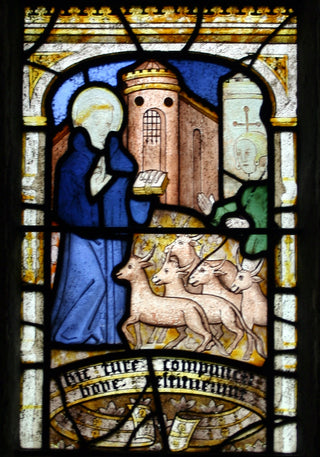
OUR PATRON SAINT
Aneitus
It is impossible to be precise about the life of our Patron Saint. Charles Henderson, the Cornish historian, suggested that the saint who gave his name to the parish was Aneitus, a Celtic saint who lived and preached locally. Various interpretations of his life written by academics in the Middle Ages tend to differ, but that he was a good and learned man seems beyond doubt. Well respected for his piety, humility and spiritual counselling one legend tells of this man of small stature standing up to his neck in water while reciting all 150 of the Psalms. It is believed he died in approximately 877, and his remains were said to have been in the north wall of the Chancel, from where they were stolen in 974, and re-interred at St Neots in Huntingdonshire.
Early life of Aneitus
Neot was born into a minor branch of the West Saxon royal house, in the first half of the ninth century, somewhere in Wessex. Neot's father was named Ethelwulph. In early life he was under pressure to become a soldier, but when he was old enough, he devoted himself instead to a religious life. As a young man therefore, he became a novice monk, living in Glastonbury in Abbey, about the middle of the ninth century. He was extremely studious.
He is likely to have been given an Anglo-Saxon name by his parents, but this is not recorded. The word neophyte was commonly used at the time for individuals who had newly undertaken religious vows, and Gorham speculates that he might have been called "Neophytus", the Latin form of neophyte, at the monastery by monks who noticed his application to religiosity. In time, this might have been abbreviated to "Neotus", the Latin form of the name by which we know him now.
He was admired for his literary attainments by the other monks; and he was known for his humility and religious devotion. In addition to the religious observances prescribed by the monastery, he often awoke in the middle of the night and went to the chapel secretly to pray, in the disguise of a penitent, returning at dawn to continue the ordinary monastic routine. In due course he was admitted to Holy Orders, and later he was made a Sacristan of the Abbey. The fame of his scholarship and devotion attracted many pilgrims from all parts of the country, who went to Glastonbury to receive the benefit of his wisdom.
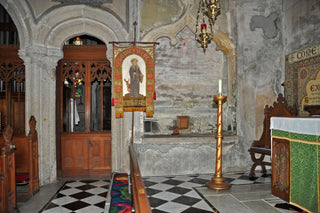
VICAR BECAME A LEPER
LEPER's SQUINT
A Leper's Squint is located in the wall to the left of the altar. "In 1313, the vicar having become a Leper, the Bishop appointed a coadjutor and ordered certain apartments in the vicarage to be set aside for the Leper's own use. In 1321 the Church was re-dedicated, but it was wholly rebuilt on the present magnificent scale in the following century." (Henderson, Cornish Church Guide). The Ogee arch by the squint is certainly older than the other arches in the church. Suggestions have been made that the stone of this arch could have come from the earlier building, the medieval fragments of wall painting are just to the side of the squint and Ogee arch. One might speculate if this small part of the building near to where St Neot's bones were kept original during the 1400's re-building preserving the previous century's squint that was built for the"Leper" vicar.
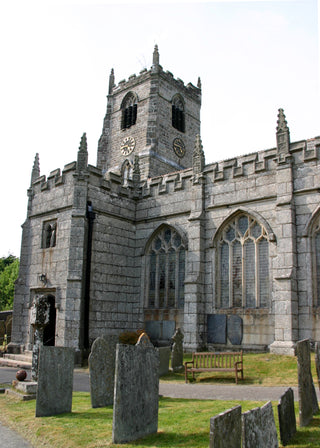
Precison cut granite
Construction
Great skill was used when the Church was built in about 1425, with the huge blocks of granite used in the construction cut to precision and the seven pointed arches separating the south aisle from the nave being completely uniform. On the north side of the Church the seventh arch at the east end is clearly older than the others and lower and may have been the entrance to a chapel.
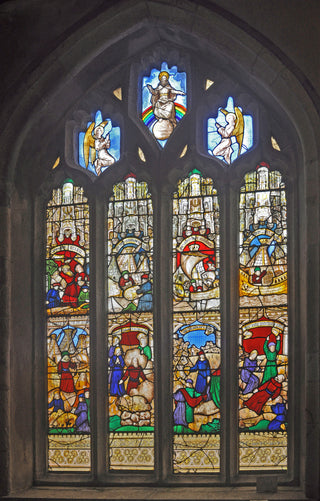
Stained Glass Windows
The windows are well worth viewing, preferably on a sunny day! The sun shining from the south at midday provides excellent light to view the vivid colours of the south wall windows from inside the Church. Robert Tubbe, Vicar from 1508 to 1544, was possibly the man behind the present designs which were greatly restored by John Hedgeland in 1826-28. During this restoration Hedgeland changed parts of windows, and shifted them around, so that it is now impossible to know what they were originally like. Nevertheless in twelve of the windows, half of the glass is original. The finest and least restored window, the Creation Window, is at the east end of the south aisle and is full of delightful things representing the Creation (including the newly created bird flying off the tip of His finger), the Fall, Cain and Abel and lastly Noah politely doffing his cap to God as he receives his instructions, while the first window in the south aisle represents the story of the Flood and Noah. Some of the wealthy parishioners funded the remaining windows, and those in the south aisle were donated by the Borlase, Martyn,Motton, Callaway and Tubbe families. The last window in the north aisle was given by the young men of the parish and depicts 12 scenes from the life of St.Neot. A further 12 scenes in the west window of the north aisle describes the life of St. George and is of unique interest as some of the legendary incidents are not found elsewhere. The east window above the high altar dates mostly from the 1820’s. The 8 small top lights are some of the oldest stained glass in the church, these top lights date from the 1460’s. Hedgeland’s work extends to the two in the organ chamber and the Armorial window to the left of the south door.The Grylls family have long been patrons of St Neot Church, and Rev R.H.Grylls, a descendant of the Callaway and Tubbe families, commissioned John Hedgeland to undertake the restoration work. "Google" Hedgeland stained glass St Neot for more information.
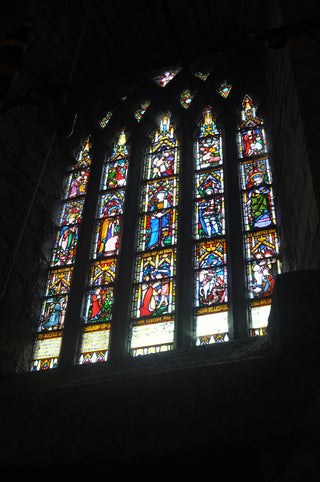
ETCHED GLASS
Belfry Screen
In 2004, Richard Grylls, the present patron, engaged the services of Arthur Bradley to replace the frosted window at the west end of the Church, which obscured the belfry, with a new etched glass screen. This new window contains etchings of a dove, mirroring the dove over the baptismal font, together with fruits of the vine, and wheat from the fields, as well as a porcupine – a symbol from the Grylls family crest, and denoting both plenty and realisation of hopes.
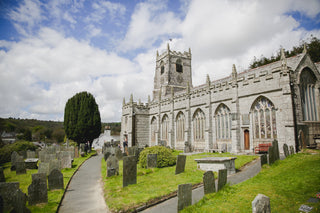
SEVENTEENTH CENTRY
Slate Tomb
At the west end of the north aisle is a very fine early seventeenth century slate tomb chest on which are the kneeling figure of William Bere and his wife, part of the carved eulogy reading ‘Here lyeth Bere whom Angels to heaven beare’.
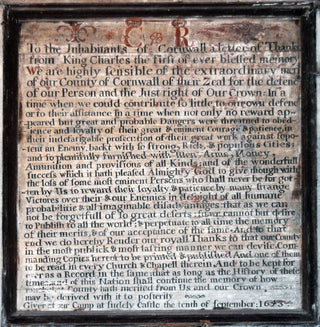
LETTER FROM THE KING
King Charles
High on the north wall at the east end of the Church is a copy of the letter written by King Charles from his camp at Sudeley Castle on 10th September 1643 to the inhabitants of Cornwall thanking them for their Royalist support during the civil war.
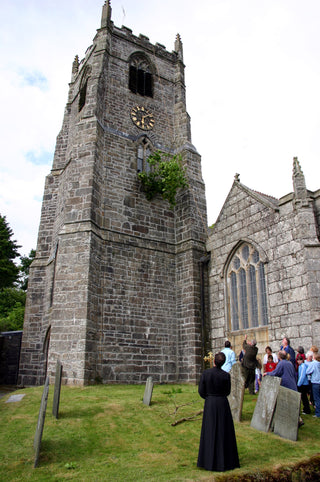
Oak Apple Day
Every year on Oak Apple Day, May 29th, an oak bough is raised to the roof of the tower and secured. It remains there until a placement is raised the following year as a constant reminder of St. Neot’s previous Royalist inclinations. Having lost the Battle of Worcester in September 1651, the future King Charles II escaped theRoundhead army by hiding in an oak tree near Boscobel House, Shropshire. Charles then fled abroad until his restoration in 1660. The ceremony was originally carried out on 29th May to celebrate the restoration of the monarchy in 1660 (King Charles II). On that day King Charles II rode back into London to reclaim his crown and declared that day a public holiday. This ceremony has continued in St Neot and is one of a very few in the country where this still happens. On the Frith 1893 post card of St Neot you can clearly see the Oak Branch at the top of the tower. We have researched our Church Wardens Accounts and found out that annually since 1660 (up until 1859) the bellringers were paid one shilling for their services! For further photos see the Church Interior page and the Oak Apple Day photo page. Male villagers wear an Oak Sprig in the morning changing this to a sprig of Boys Love (Artemisia abrotanum) at midday. If this procedure is not adhered to you run the risk of being stung by nettles! It was repealed as public holiday in 1859 it was a Bank Holiday, but St Neot continued with its celebrations. More information and folklore tradition is available on-line. There is even a movement to have the Bank Holiday re-instated!

Wood carvings